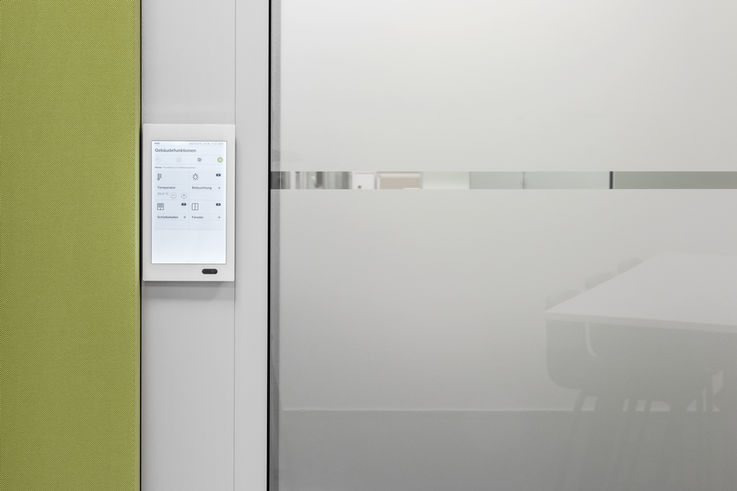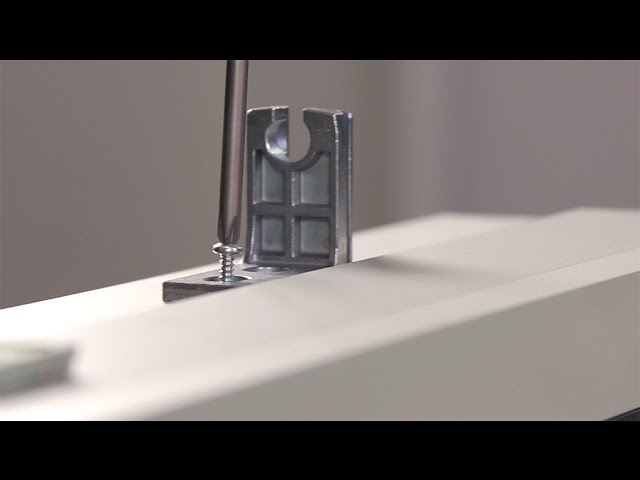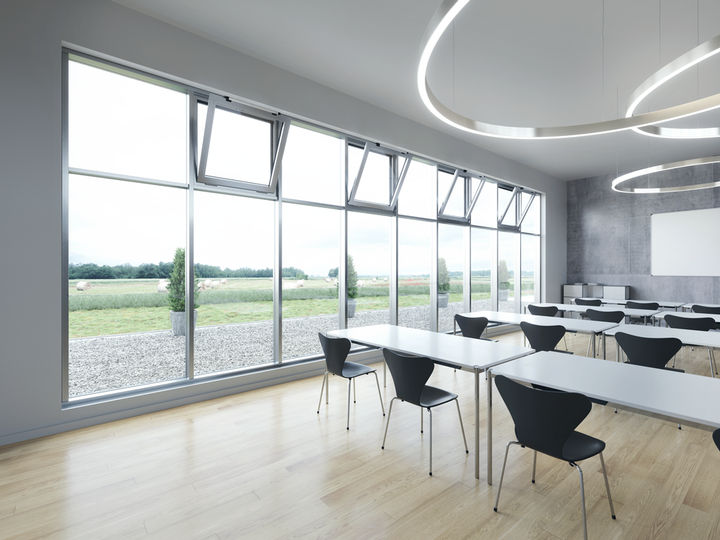Fresh air through indoor climate control
Modern man spends about two thirds of his life indoors. It is clear that the quality of the indoor air has a great influence on our well-being. To ensure good air quality and a pleasant indoor climate at all times, buildings are increasingly being equipped with intelligent indoor climate control systems – for greater comfort and better energy efficiency.
Good indoor air and thermal comfort
Since we all perceive our environment differently, there can be no one measure and definition of well-being’. However, it is possible to create room conditions in which most people feel good. Air quality and thermal comfort must be taken into account when planning buildings. Meaning: the CO2 content, the temperature, the humidity and the air movement in the room.
The technology here is already well advanced: The indoor climate can be monitored and optimised with sensors and individually selectable settings. The objectives are both the well-being of the room users and the minimisation of the energy used for this purpose. So well-being and energy saving in automated form: when the room is occupied, the comfort of its users drives how the climate is controlled; when it is not in use, energy efficiency is at the forefront. Further advantages are the protection of the building stock and the fabric of the building because damage caused by penetrating rainwater or mould caused by excessive humidity is avoided.

Touch panels enable operation via a display. © GEZE GmbH
Control via sensors for greater air comfort
Sensors measure indoor air quality on the inside and solar radiation, precipitation, wind speed and temperature on the outside. Heating, cooling, solar protection equipment and automated windows are then controlled on the basis of this sensor data, The CO2 concentration is the most important indicator for the quality of indoor air. The CO2 content of the indoor air increases with the number of people and duration of their stay as well as the intensity of their physical activities. The higher the CO2 load in the room, the more fresh air the controller demands.
Room controllers, often also with touch displays, serve as operating units in the individual rooms. They are the user interface to the building, i.e. the users can select the room temperature themselves. Cooling through the air-conditioning system and the fresh air supply through automated windows are coordinated.

Indoor climate control in a gymnasium with natural ventilation
Time-controlled room ventilation and scenarios selectable
The indoor climate control also enables time-controlled comfort functions such as the automatic opening and closing of windows, shutters or blinds at certain times of the day. For example, intensive ventilation, the so-called fresh air flushing, can take place before the first employees arrive. In summer, the ‘night-time back cooling’ function uses cool night-time and early morning air to cool the rooms naturally and thus save energy costs for cooling.
In addition, different scenarios or different energy levels can be selected for each room, such as comfort, standby, economy (night reduction) or building protection. The scenarios can be switched via time programs, presence detection or manual operating buttons. Further possible scenarios with optimum values for lighting, ventilation and sun protection can be selected in addition, e.g. meetings, presentations or office work.
Communication via building buses or radio
Different bus systems (e.g. KNX or BACnet) are available to enable reliable communication between actuators and sensors. Wireless extensions (including ZigBee, Z-Wave, EnOcean or KNX-RF) are also used. These enable buildings to be automated retrospectively, without the need for complex cabling.
Characteristics of an indoor climate control system
- Depending on solar radiation, precipitation, temperature, CO2 content, humidity and presence, the control system for each individual room determines how the various components (window drives, blinds, heating, air conditioning, etc.) are controlled.
- Use of solar energy or avoidance of heat loads through solar inputs
- Bundling in an intelligent control system increases the efficiency of the individual components. For example, the air conditioning system is put into operation only if natural ventilation is not effective enough and if all windows are closed – fully automatically.
- Protection of stock against climatic influences: as soon as rain or critical wind conditions are detected, windows close automatically.
- Thanks to the intelligent control system, windows, for example, are open only when external influences permit – and when desired. This means the days of windows being forgotten and left open all night are a thing of the past.
- Weather modules report wind, precipitation or ice formation promptly and ensure that the solar protection is retracted in good time to prevent damage.
- Automatic ventilation prevents mould from forming when the humidity is too high.
- Well-being, thermal comfort and performance thanks to pleasant lighting conditions, air quality and temperature
- Unnecessarily strong ventilation is avoided.
- Tolerance for user intervention: users have the possibility to change e.g. temperature, light and ventilation.
The system will subsequently ensure that everything is restored to its original state if the user forgets.
GEZE ventilation and indoor climate control
The GEZE indoor climate control system for controlled natural and energy-saving ventilation complements the GEZE window drive and RWA programme. The RWA systems can also be extended by sensors and control elements and can be integrated into building management systems.
Via the IQ box KNX interface module, GEZE enables the simple integration of automated window drives in KNX environments – for intelligent interaction of window drives and sensors. Other KNX-capable systems and drives or building technology components, such as solar protection systems, heating controls or air conditioning, can also be linked to the GEZE indoor climate control.
GEZE offers numerous possibilities for the automation of indoor climate components. Our fully automatic control is project-specific, extremely flexible and easy to expand.
Sven Kuntschmann, window technology segment managerWith the IO 420 interface module, all GEZE system components become ‘networkers’. Automatic door systems, ventilation technology and smoke and heat extraction systems (RWA) as well as safety systems can be integrated into the higher-ranking building management system via BACnet in order to automate their functions. GEZE thus makes a contribution to the Smart Building through intelligent building networking.
Since the demands on indoor climate control and sophisticated ventilation controls are very different, these solutions are individually planned depending on the building project. The GEZE Customer Solution Team is happy to help with concept and planning.
The GEZE range of services and products for indoor climate control
- Drive systems for aeration and ventilation
- Ventilation solutions: simple open/closed control of individual windows or groups of windows through to comprehensive central controls
- Comfort solutions for automatic ventilation depending on weather, temperature and air quality
- Simple radio-based solutions for individual rooms up to comfortable room/building control systems controllable via a modern touch display
- Intelligent RWA control units also enable ventilation functions
Go to the GEZE IQ box KNX interface module
System example: gymnasium with RWA and indoor climate control

Diagram of indoor climate control in a sports hall © Elsner Elektronik GmbH / GEZE GmbH
A building with various rooms serves as an example: gymnasium, entrance area, technology room, locker rooms and shower rooms.
Indoor climate control
- Optimum indoor climate in the sports hall for the hall users, since ’fresh’ air is supplied depending on the air quality (mist), humidity (sweat) and temperature.
- Manual intervention is possible if the automatic functions do not meet the needs.
- In rain and strong winds, a rain/wind sensor on the roof closes all the windows automatically, thus protecting the building stock.
- Automated ventilation offers comfort for users, prevents mould and its effects on health, and avoids premature renovation being required.
- The automatic closing of the windows outside operating hours protects against burglary and needs no additional intervention by the caretaker.
The smoke and heat extraction (RWA) guarantees
- personal protection (keeps escape routes free from smoke)
- environmental protection (reduction of environmental damage by minimising the use of extinguishing agents)
- protection of property (maintains the building structure by minimising thermal loads and ventilation of the fire)
- Motorised fanlight windows opening outward are integrated into the gymnasium façade.
- During normal operation, the hall is automatically ventilated via the fanlight windows depending on the indoor and outdoor temperature, humidity and air quality (CO2).
- The fanlight windows can also be opened or closed manually in separate groups via vent switches.
- The façade is equipped with blinds for shading, which automatically extend depending on the brightness and position of the sun, but do not collide with the fanlights.
- Motor-driven roof windows are installed in the gymnasium’s roof of the hall, which open when smoke develops and conduct the smoke out of the hall (RWA).
- An uninterruptible power supply (UPS) ensures that 230 V devices (blinds) are safely opened in the event of a fire (RWA).
- The building entrance door, the connecting door to the corridor and the door to the gymnasium serve as an exhaust air opening (RWA).
- There are motor-driven façade windows in the entrance area.
- Windows are operated manually via push buttons and close automatically at the latest outside the operating hours.
- There is a motor-driven façade window in the technology room.
- The window is operated manually via a push button and closes automatically after a preset time (e.g. 30 minutes).
- There are two motor-driven fanlights in each shower room.
- Fanlights are controlled as a function of humidity and indoor and outdoor temperature.
- Windows can also be operated manually via push buttons.
- Mould infestation can be avoided.
- There are two motor-driven fanlights in each of the locker rooms.
- Fanlights are controlled according to air quality, humidity and indoor and outdoor temperature.
- Windows can also be operated manually via push buttons.
Product video

GEZE Powerchain chain drive for automatic room ventilation
Sophisticated solutions from a single source
GEZE indoor climate controls are customer-specific applications consisting of combined RWA and ventilation systems. With Customer Solutions from GEZE, you benefit from sophisticated, individual solutions that offer the best possible safety and convenience. And all this from a single source. Your contact person will answer all your questions, from the initial idea right up to the commissioning.
- Natural automatic ventilation has a very high acceptance among end users, especially if they can intervene manually (e.g. by local ventilation buttons).
- A ventilation concept based on natural ventilation minimises or avoids the planning of ventilation shafts in the building. Compared to mechanical ventilation, no additional ventilation openings are necessary in the façade and thus do not influence the architectural design of the façade.
- low-noise operation (no fan noises)
- lower investment, installation and maintenance costs than mechanical ventilation systems
- Consultation-friendly, reliable planning, scalable:
with the compact drive control modules, various ventilation concepts (individual, group, central controls) can be easily planned and scaled.
Installation, commissioning and operation made easy
We offer simple assembly and commissioning, e.g. by circuit diagram and description on individual drive controls. This reduces sources of error and ensures speedy connection. The scalability of the control allows maximum flexibility and the spare parts can be stored in the service vehicle as only a few control types are in use.
Comfort and freedom
GEZE is your partner at every stage of your planning. From the first consultation, through to installation and after-sales service. Thanks to our industry know-how, we are able to recommend individual property solutions quickly, as the approaches here are usually very similar.
GEZE indoor climate control systems promise:
Comfort
- automatic ventilation and manual intervention possible
- intuitive central control via a modern touch display or simply via local push buttons (depending on the solution)
Freedom
- ‘real’ fresh air
- manual intervention via push button





